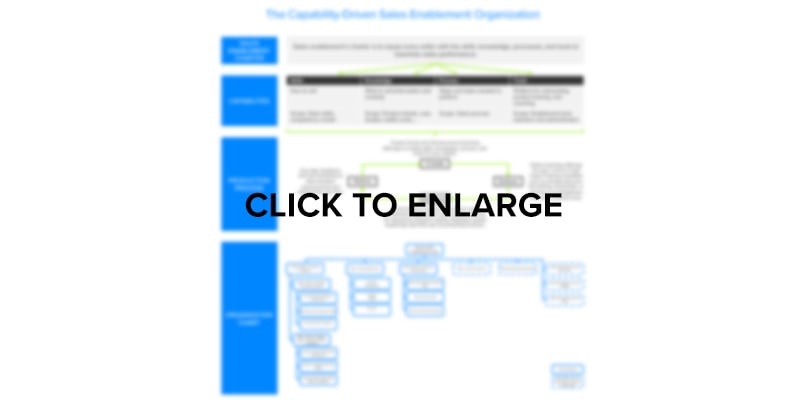
Recently, an associate at a rapidly growing SaaS startup asked me, “How would you structure a sales enablement organization?”
My immediate response was, “It depends.”
Dissatisfied with my answer, I sought the opinion of sales enablement and sales operations leads at six similar SaaS companies in the San Francisco Bay and Seattle areas, each with 1,000-2,000 employees and 300-400 sellers. Based on these interviews, I derived a four-step approach and framework for simplifying the task of designing a scalable sales enablement organization.
Step 1: Define and agree on a sales enablement charter
When designing or restructuring an existing sales enablement organization, first identify the capabilities sellers need based on your leadership’s goals. Below is a straightforward charter that can be tailored for a sales team or organization:
The charter of the [name] sales enablement team is to equip every seller with the skills, knowledge, process and tools to maximize sales performance.
Step 2: Operationalize the charter into sales enablement capabilities
Based on the charter above, the necessary sales capabilities include:
Skills: Support a consistent selling approach; whereby sellers “speak the same language.”
Knowledge: Provide the right information and context about products and services, and confidently tailor responses to customers’ unique needs.
Process: Understand how to move customers through a sales funnel by supporting the lead nurturing process. Recognize the difference between sales leads, prospects, and opportunities.
Tools: Participate in training and coaching through virtual and on-demand learning.

Step 3: Develop a sales enablement production process
Sales enablement should be viewed as an end-to-end process that transforms resources, such as money and your sales enablement teams, into defined outputs or services, such as instructor-led training, bootcamps, and knowledge bases.
An efficient process will create many opportunities to refine and improve sellers’ skills, knowledge, and training tools. Essentially, sales enablement creates and delivers sales enablement services, measures success, and continuously refines the process based on data, feedback, and benchmarking.
Step 4: Build a sales enablement organization chart
Next, identify individuals responsible for creating formal and informal training that supports your identified capabilities; in this case, skills, knowledge, process, and tools. Additionally, delegate staff to deliver, measure, and refine training and other sales enablement activities.
CREATING AND DELIVERING TRAINING
Formal sales training can simplify and scale onboarding, providing new skills and knowledge, and increasing process know-how. These applications make sales enablement efforts timely, trackable, and cost efficient. Informal learning should complement formal training.
The six SaaS companies I contacted had instructional designers who developed formal, structured training for their sellers. This training was often revised and used to educate channel partners. Ideally, training should be grouped according to customer segments (e.g. enterprise and small to midsize business) since the sales approach and sales cycle for these segments often differ.
Informal learning or microlearning equips sellers with the knowledge and content to become more confident and competent in their roles. Because sales people have limited time to sift through lengthy documents, informal learning content should be succinct, relevant, engaging, and, if possible, in standardized formats. Examples of this type of training include case studies, product sheets, battle cards, how-to videos, webinars, podcasts, and even sharing best practices during lunch.
None of the SaaS companies I interviewed had instructional designers that developed informal training. Based on research and in my experience, however, sellers only learn 10 percent of what they need to know via formal training. Most of their knowledge and skills are attributed to coaching, peer-to-peer learning, and informal training resources.
Training can be delivered in-person, virtually (live or on-demand), or via self-serve channels, such as knowledge bases or training portals. Having a training team isn’t a requirement if you have subject matter experts who are comfortable sharing their knowledge.
PROVIDING COMMUNICATION AND SALES ONBOARDING
Few of the companies I contacted had dedicated resources to ensure sellers were regularly updated with new training, webinars, customer pitch decks, price lists, and other crucial sales materials.
Communicating with sellers can be as simple as emailing or posting online a bi-monthly or weekly sales enablement newsletter with links to new resources. Your marketing team can help socialize and strengthen your enablement initiatives and activities by developing key sales materials and communications.
DEFINING TOOLS AND PROCESSES
By formalizing tools and processes, you can more easily scale sales operations and enablement programs. For instance, sales operations typically develop sales forecasts, whereas sales enablement determines how to achieve the necessary sales. By enabling both organizations to use the same tools, you will increase efficiency and collaboration. You will also ensure data is sharable for reporting and analysis.
ANALYZING SALES ENABLEMENT
Recently, there’s been a push to use data and insights to systemically understand which sales enablement activities produce the best results and pinpoint the root causes of inferior sales efforts. Surprisingly, only one of the companies I contacted used data to analyze and drive sales enablement performance.
Data is essential for justifying value and proving ROI when requesting additional resources. A sales enablement organization should not only leverage data but also have a dedicated analyst.
At the minimum, evaluate which sales resources are being used. Ask sellers to rate the effectiveness of these resources for engaging customers. Equally important, develop key performance indicators to measure sales ramp-up time, training, and content. Use key sales metrics, such as quota attainment and win rates, to determine how you can “move the needle,” either by supplementing sales competencies or improving your portfolio of sales assets.
APPOINTING REGIONAL SALES ENABLEMENT LEADS
As your company expands, establish a process for onboarding sellers in new regions or countries. It’s important to have a dedicated resource, even if you need to hire a contractor until you have the budget for a full-time resource. And since sales enablement and training programs should be tailored to sellers’ needs, you’ll need to be prepared to translate training assets into different languages.
Conclusion
Every company has different sales needs and requirements. This four-step approach and framework provides a starting point for building and developing a sales enablement organization that can help sellers excel at their jobs.
I look forward to your feedback and questions.
Thank you to Courtney A. Skay, Andrea Ihara, Julie Greenfield, Kenny Hsu and several others from the sales enablement and sales operations community who provided valuable input for this article.
